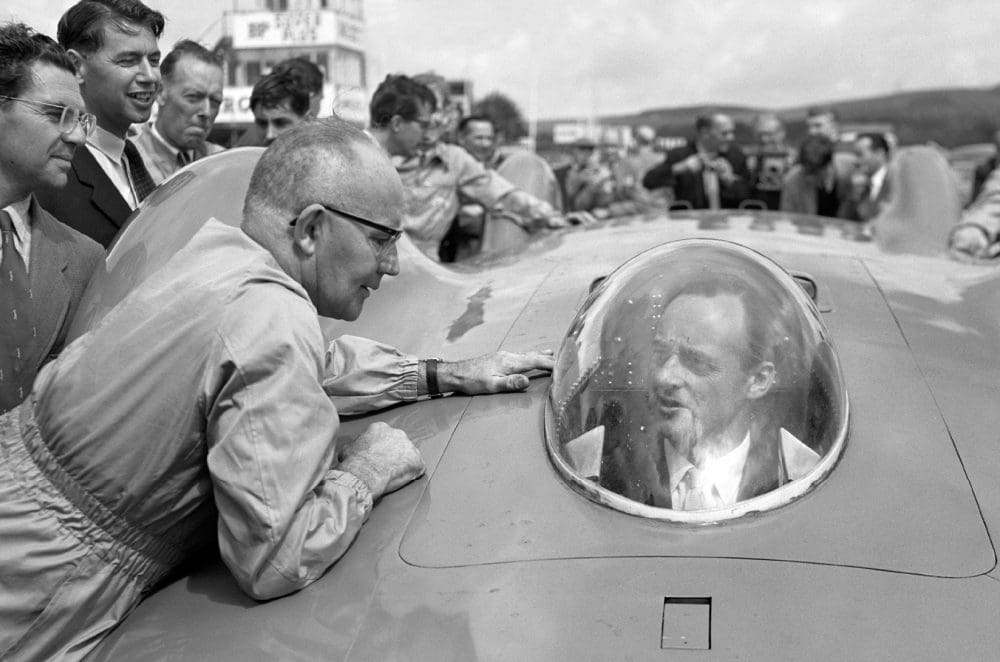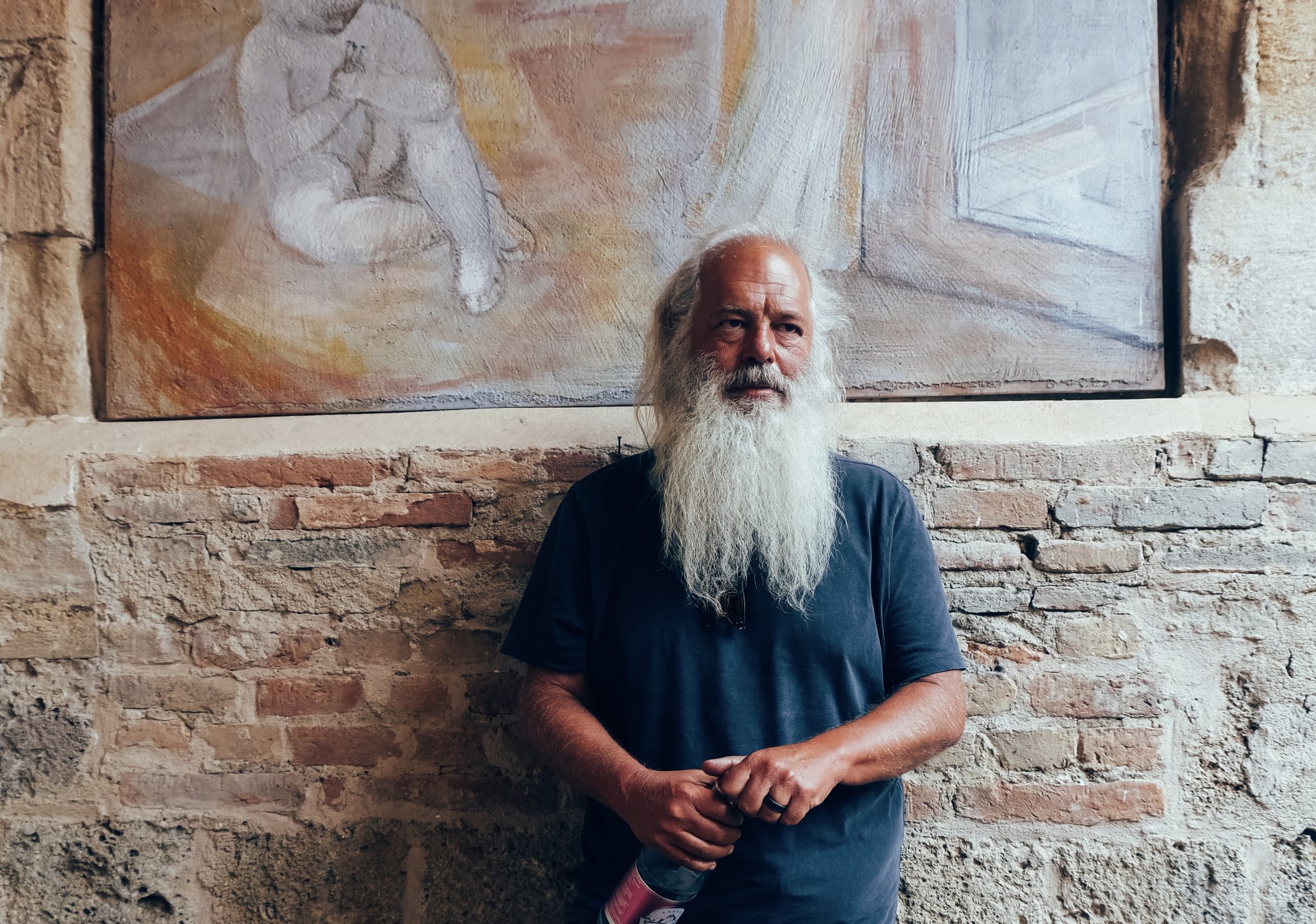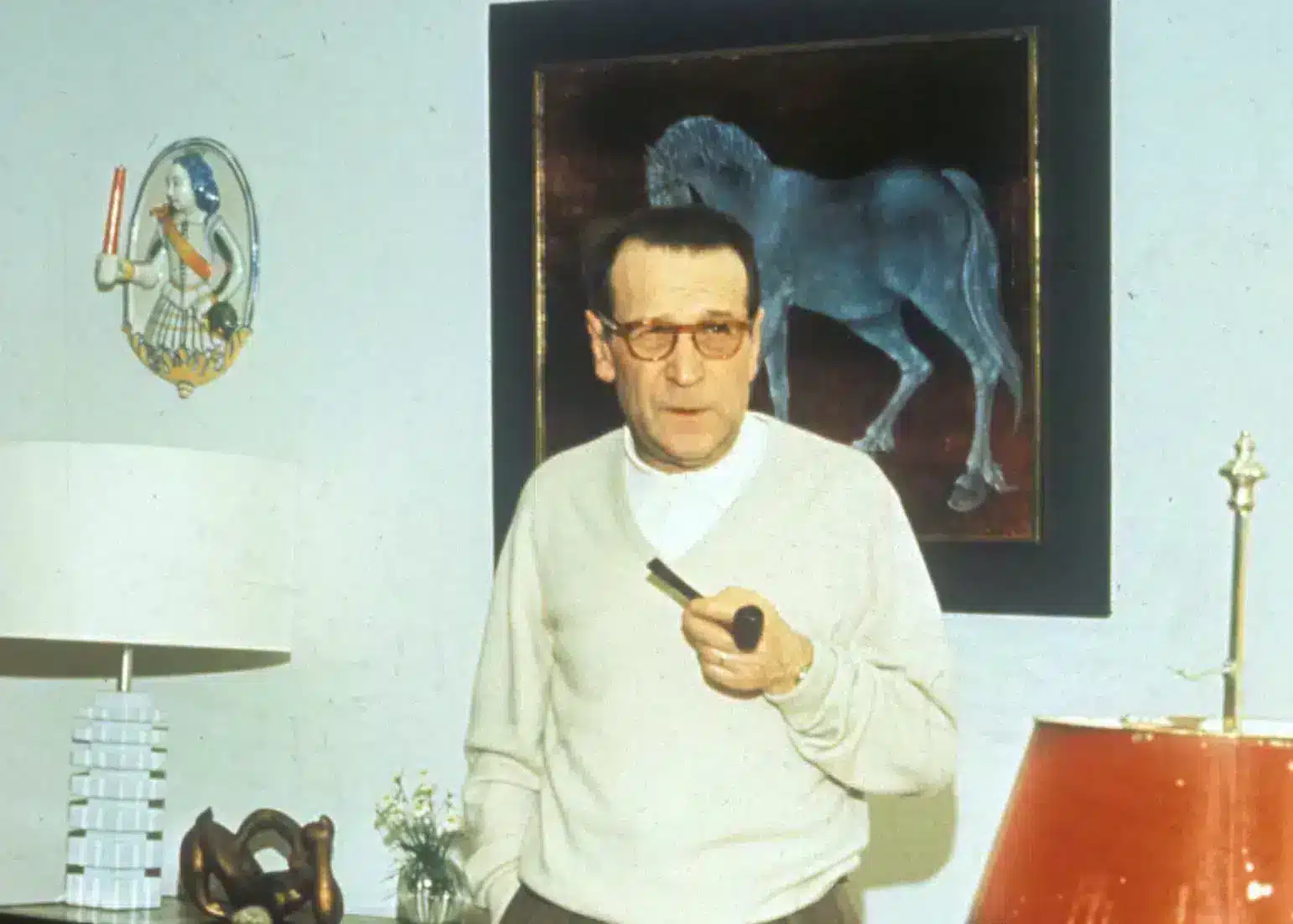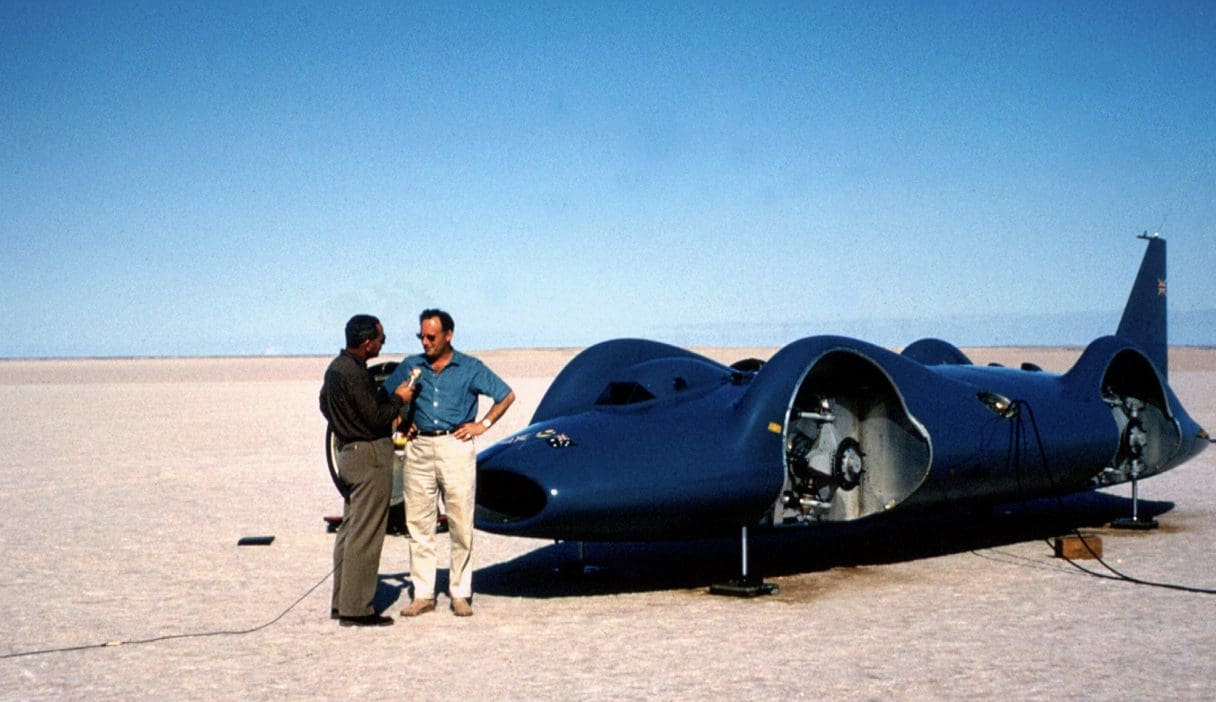
“Travelling quickly, of course, is nothing” Donald Campbell once said—a curious stance to take for a man who spent his entire life (and eventually gave it) in pursuit of the unpursuable: an ever-receding quest to travel not just quickly, but quicker than any human ever before, and then quicker again even than that. What he meant, perhaps, or at least half-intuited, was that the speed itself—394 mph, 407 mph, 500 mph—was never really the end, but the means. That in travelling quickly, perhaps, other things might be encountered and realised along the way—as if on the other side of the sound-barrier some new realm and understanding might lie. Here, perhaps, there would at last be parity and peace with Campbell’s father—the 1930s daredevil Sir Malcolm, who broke 13 speed records in his own lifetime, but disdained his son at home. Or maybe there’d lie Britain in some pre-war, peak empire, long summer afternoon—when the Americans knew their place and the sun never set on British scalps. (Speed records, he once told an interviewer, were the only real measure of a nation’s “virility”). “Once we cease to have a desire to do these things,” Campbell said, “we will stagnate and die very rapidly.”
Donald Campbell, as anyone alive in Britain in January 1967 will know, never quite found that place. It’s impossible now not to watch his life backwards—beginning at the final black-and-white frame of his rocket-boat, Bluebird 2, lifting out of the water, like a strange metal lobster departing the surface of the lake, in the seconds before it disintegrated into a hundred pieces under the monstrous weight of physics and ambition. This final, absurd leap gave Campbell’s quest genuine heroic status once and for all, especially in a nation that always worshipped the underdog, the valiant failure, more than the victor. Campbell was a hero, despite—and, actually, because of—his great folly. “It’s like a mountain that has to be climbed, or a song that has to be written,” the man once said of his pursuit of further, wilder speed records. What he didn’t see, of course, is that songs don’t always have to be written, and mountains don’t always have to be climbed. On the morning of his death, his wife, Tonia Bern-Campbell, said of his final record attempt: “I want it to be the last, but I don’t think it will ever be the last.”
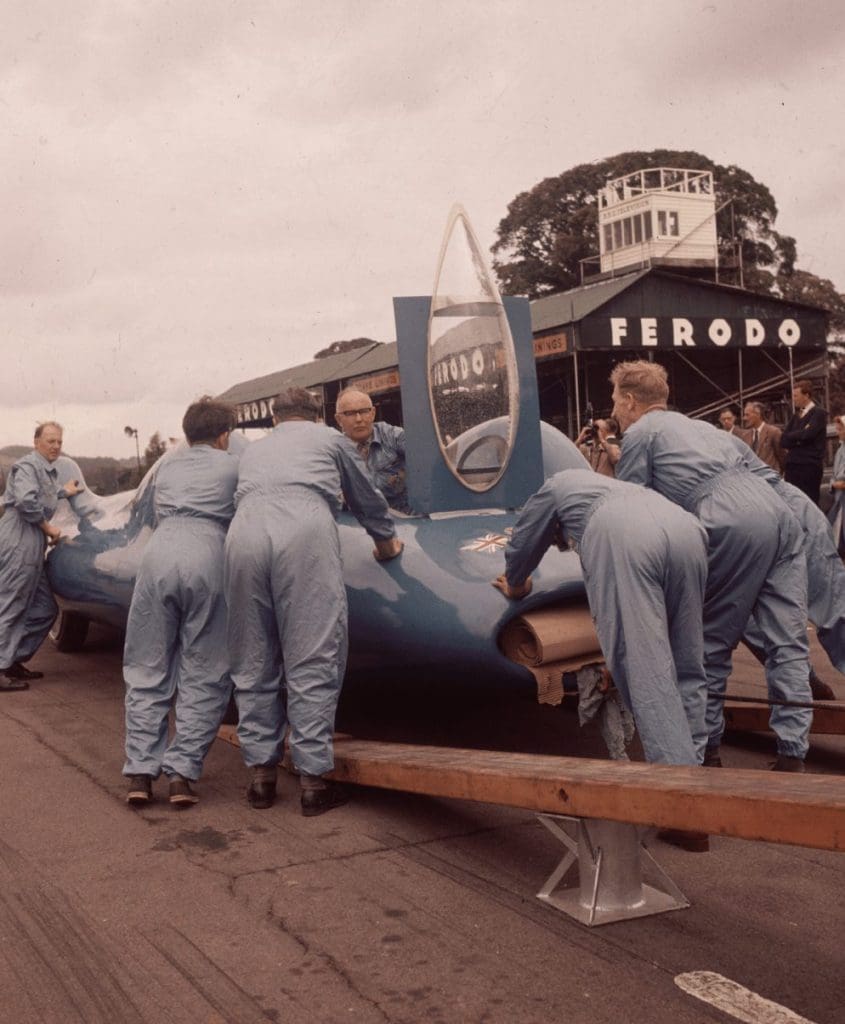
Campbell was born in March 1923 in Surrey, the son of Sir Malcolm Campbell, whose steely exploits across the 1920s and 30s in his Bluebird cars and boats were a tonic to inter-war Britain—a pepper-upper for the chattering classes as potent as all this jazz nonsense and that moreish new prescription cocaine. Campbell Snr was a motorcycle dispatch rider who served at Mons in 1914 before being drafted into the Royal Flying Corps. After the war, he was knighted by George V for his daring exploits in a series of ever-faster cars and boats. He bullied his son Donald at home, family members said, and goaded him for his relative lack of nerve. In 1939, Donald volunteered for the Royal Air Force, but was blocked from serving due to a childhood bout of rheumatic fever. When Sir Malcolm died of a stroke in 1948, Donald almost immediately sat down with his father’s chief engineer from his record-breaking days, a man called Leo Villa, and set about chasing speed himself.
At first Campbell used his father’s old boat, the Bluebird K4, for his water-speed record attempts, but soon realised that it was a craft for another man and another era—a propellor-powered beast that was being outstripped by a leaner model piloted by the American Stanley Sayres. So Campbell worked with Villa to develop his own machine—an all-metal, jet-powered thing called Bluebird K7: not so much a boat as a rocket-plane that just happened to find itself on the surface of a lake. K7’s unlikely form and explosive power helped Campbell set seven world water speed records between July 1955 and December 1964. His exploits on Lancashire’s Lake Coniston soon became tourist attractions in their own right—jolly, deadly feats bankrolled heavily by Mobil and later BP.
The question of a land speed record, however, was less clear cut—and Britain’s green and pleasant hills meant it was difficult to test any car to its maximum capabilities at home. The Americans, with their post-war industrial might, seemed to be surging ahead, mainly on the eerie blankness of the Bonneville Salt Flats in Utah. The land speed record was still held by John Cobb, a Brit, who’d hit 394 mph back in 1947. But an American daredevil called Craig Breedlove was inching ever closer. Villa, Campbell, and a pair of engineers known as the Norris brothers set about designing a car called Bluebird CN7, which they hoped could top 500 mph. The entire British motor industry—including BP, Bristol, Dunlop, Smiths Industries and Lucas Automotive—huddled together to help. The resulting blue craft, low and sleek and curvaceous, like some darting lizard, became a totem of British pomp and power. Campbell appeared on tourism adverts. Toy models of the car were put in cereal boxes.
On Bonneville, however, disaster struck. “You’re travelling faster than a .45 calibre bullet”, Breedlove said of the salt flats. Any error would be catastrophic. In July 1960, On the stage where his father had gained his final ever land speed record, Campbell lost control of Bluebird CN7 at 360 mph. The car took off into the air, flew for 400 yards, and bounced three-times on the hard salt before coming to rest. Miraculously, Campbell survived with just a fractured skull and burst eardrum. As the ambulance drove him away, he shouted to his wife that “the crown jewels” were happily intact. Even this failure could be re-framed as a feat: “I suppose I have survived the fastest crash that mankind has ever survived,” Campbell said as he was interviewed in the hospital days later.
Campbell blamed the course itself, and set about finding a bigger, longer, flatter alternative—eventually settling on Lake Eyre in Australia. It hadn’t rained on the dried-out, paper-flat lakebed for nine years. But, as if in some cosmic pantomime, the heavens opened on the precise week the Brits turned up—softening the footing and dashing any serious speed attempts. At the same time, the youthful yankee Breedlove had just reached a speed of 407.45 mph in his pointedly named “Spirit of America” jet car—and was touted in the international press as the fastest man on earth. It was a damning blow to Campbell’s confidence. This was a man who had always been intensely superstitious—fearing the number 13, hating the colour green, and maintaining that nothing good had ever happened on a Friday. His worldview seemed to darken.
By the mid 1960s, Britain was cooling on speed. Campbell was seen as a what-ho figure from another era, at a moment when the youth was defiantly shaping its own. Money dried up for record attempts, and public interest waned. But Campbell still wanted to regain his crown, and drew up plans for an ambitious—and highly expensive—new rocket car. Remembering his popularity on the surface of Lake Coniston, he remarked to friends that he’d never been finished as long as he still had his trusty Bluebird K7 boat. In December 1966, Campbell dragged the old girl out of retirement in an attempt to once again break the water-speed record—but problems with the fuel system meant it topped out at a forgettable 250mph. Leo Villa managed to fix the problem over several weeks and eventually generate more power, and the team waited until the ghastly winter weather cleared to mount one last hurrah. “That’s the terrible thing about trying to break a record,” Campbell told an interviewer in December. “Once you start, you’re past the point of no return.”
On the morning of January 4th, 1967, Campbell phoned his wife, Tonia. He said that he couldn’t wait to get out of the dank murk and fog of Coniston, and she cautioned him against any impatience or haste—the cause of all disasters, he’d often told her, in the speed-record world. The pair had always ended their calls with a teenage flirtation—each refusing to hang up before the other one. But on that morning, Campbell signed off with an enigmatic “look after yourself, won’t you,” Tonia recalled. “And afterwards I thought—why did he say that?”
Just after 8.45am, a local boat boy that Villa and Campbell had hired saw the craft manoeuvre slowly out into the centre of the lake, following an encouraging if unremarkable warm-up run. Bluebird straightened herself up on the glassy waters, the wash from the run before just subsiding, before a deafening blast signalled that Campbell had applied full throttle to the craft. A few seconds later, 700 metres down the craft, the craft began to hover and oscillate almost imperceptibly above the surface of the water, before beginning to bounce more violently against the dark glass. Campbell’s final words, caught on the intercom to Villa, lasted 31 seconds.
“… Full nose up … Pitching a bit down here … coming through our own wash … er getting straightened up now on track … rather closer to Peel Island … and we’re tramping like mad … and er … FULL POWER … er tramping like hell OVER. I can’t see much and the water’s very bad indeed … I’m galloping over the top … and she’s giving a hell of a bloody row in here … I can’t see anything … I’ve got the bows out … I’m going!…”
Then the serene and sudden and violent arc, the desperate backflip, the contorted cartwheel, and the silence and smoke and stillness. Rushing over by boat with the local boy, Villa almost immediately spotted Campbell’s longtime mascot—a soft, stuffed bear known as Mr Whoppit—bobbing smilingly on the surface of the water. The boat boy swore the crash made no noise on its impact. Villa said he knew instantly that the game was over. Most of the craft was not recovered until years later. Campbell’s body was finally discovered in 2001, still wrapped in the royal blue overalls that were his signature.
In the last interview before the attempt, Campbell answered his critics and stated his case once and for all. “Some people say I haven’t grown up,” he laughed, his voice a perfection of cut-glass English poise and pose. “Well, I accept it. And I’m not in a hurry. There’s too much time to grow up and to grow old.” Too much, and never nearly enough.
